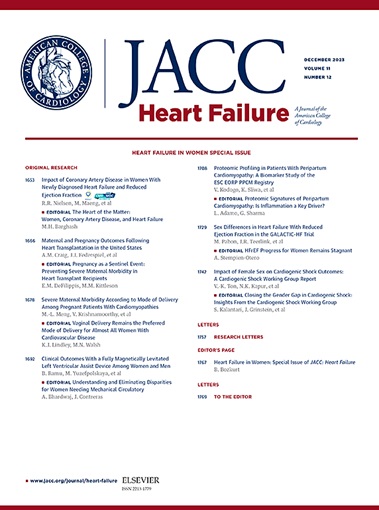Dynamic Risk Estimation of Adverse Events in Ambulatory LVAD Patients
IF 10.3
1区 医学
Q1 CARDIAC & CARDIOVASCULAR SYSTEMS
引用次数: 0
Abstract
Background
Hemocompatibility-related adverse events affect patients after left ventricular assist device (LVAD) implantation but are hard to predict.
Objectives
Dynamic risk modeling with a multistate model can predict risk of gastrointestinal bleeding (GIB), stroke, or death in ambulatory patients.
Methods
This was a secondary analysis of the MOMENTUM 3 (Multicenter Study of MagLev Technology in Patients Undergoing Mechanical Circulatory Support Therapy with HeartMate 3) trial. HeartMate 3 LVAD recipients who survived to hospital discharge and were followed for up to 2 years. A total of 145 variables were included in the multistate model with multivariate logistic regression. Model performance was assessed with the area under the curve in a holdout validation cohort. A risk stratification tool was created by dividing patients into categories of predicted risk using the final model variables and associated OR.
Results
Among 2,056 LVAD patients, the median age was 59.4 years (20.4% women, 28.6% Black). At 2 years, the incidence of GIB, stroke, and death was 25.6%, 6.0%, and 12.3%, respectively. The multistate model included 39 total variables to predict risk of GIB (16 variables), stroke (10 variables), and death (19 variables). When ambulatory patients were classified according to their risk category, the 30-day observed event rate in the highest risk group for GIB, stroke, or death was 26.9%, 1.8%, and 4.8%, respectively. The multistate model predicted GIB, stroke, and death at any 30-day period with an area under the curve of 0.70, 0.69, and 0.86, respectively.
Conclusions
The multistate model informs 30-day risk in ambulatory LVAD recipients and allows recalculation of risk as new patient-specific data become available. The model allows for accurate risk stratification that predicts impending adverse events and may guide clinical decision making. (MOMENTUM 3 IDE Clinical Study Protocol; NCT02224755)
流动 LVAD 患者不良事件的动态风险估计:MOMENTUM 3 分析。
背景:血液相容性相关不良事件影响左心室辅助装置(LVAD)植入后的患者,但难以预测:血液相容性相关不良事件会影响左心室辅助装置(LVAD)植入术后的患者,但却很难预测:目的:使用多态模型建立动态风险模型可以预测流动患者发生胃肠道出血(GIB)、中风或死亡的风险:这是 MOMENTUM 3(MagLev 技术在使用 HeartMate 3 进行机械循环支持治疗的患者中的多中心研究)试验的二次分析。研究对象为出院后存活的 HeartMate 3 LVAD 接受者,并对其进行了长达 2 年的随访。多变量逻辑回归多态模型共包含 145 个变量。模型的性能通过保留验证队列中的曲线下面积进行评估。利用最终模型变量和相关的OR,将患者分为不同的预测风险类别,从而创建了一个风险分层工具:在 2056 名 LVAD 患者中,中位年龄为 59.4 岁(20.4% 为女性,28.6% 为黑人)。2年后,GIB、中风和死亡的发生率分别为25.6%、6.0%和12.3%。多态模型共包括 39 个变量,用于预测 GIB(16 个变量)、中风(10 个变量)和死亡(19 个变量)的风险。根据风险类别对非卧床患者进行分类后,最高风险组 GIB、中风或死亡的 30 天观察事件发生率分别为 26.9%、1.8% 和 4.8%。多态模型对任何 30 天内 GIB、中风和死亡的预测曲线下面积分别为 0.70、0.69 和 0.86:结论:多州模型可为非卧床 LVAD 接受者提供 30 天的风险信息,并可在获得新的患者特异性数据后重新计算风险。该模型可进行准确的风险分层,预测即将发生的不良事件,为临床决策提供指导。(MOMENTUM 3 IDE 临床研究协议;NCT02224755)。
本文章由计算机程序翻译,如有差异,请以英文原文为准。
求助全文
约1分钟内获得全文
求助全文
来源期刊

JACC. Heart failure
CARDIAC & CARDIOVASCULAR SYSTEMS-
CiteScore
21.20
自引率
2.30%
发文量
164
期刊介绍:
JACC: Heart Failure publishes crucial findings on the pathophysiology, diagnosis, treatment, and care of heart failure patients. The goal is to enhance understanding through timely scientific communication on disease, clinical trials, outcomes, and therapeutic advances. The Journal fosters interdisciplinary connections with neuroscience, pulmonary medicine, nephrology, electrophysiology, and surgery related to heart failure. It also covers articles on pharmacogenetics, biomarkers, and metabolomics.
 求助内容:
求助内容: 应助结果提醒方式:
应助结果提醒方式:


